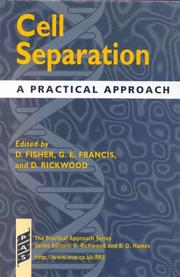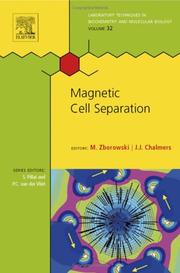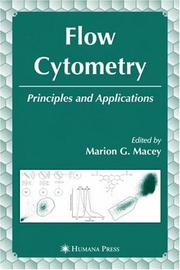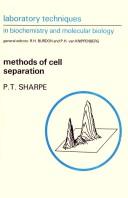| Listing 1 - 7 of 7 |
Sort by
|

ISBN: 1280375396 9786610375394 0585483477 9780585483474 9781280375392 9780191565557 0191565555 138304905X 0199635803 019963579X Year: 2023 Publisher: Oxford : Oxford University Press,
Abstract | Keywords | Export | Availability | Bookmark
 Loading...
Loading...Choose an application
- Reference Manager
- EndNote
- RefWorks (Direct export to RefWorks)
Techniques for separating cells are needed in many areas of cell biology. This text presents modern methods from the laboratories of experts in the field and includes tested, reproducible protocols, hints and tips and troubleshooting techniques.
Cell separation. --- Cell isolation --- Cell segregation --- Cells --- Cytometry --- Separation (Technology) --- Separation

ISBN: 0444527540 0080553508 9780080553504 9786611059835 1281059838 9780444527547 9781281059833 6611059830 Year: 2008 Publisher: Amsterdam ; London : Elsevier,
Abstract | Keywords | Export | Availability | Bookmark
 Loading...
Loading...Choose an application
- Reference Manager
- EndNote
- RefWorks (Direct export to RefWorks)
Cell separation is at the core of current methods in experimental biology and medicine. Its importance is illustrated by the large number of physical and biochemical principles that have been evaluated for application to cell separation. The development of cell separation methods is driven by the needs of biological and medical research, and the ever-increasing demands for sensitivity, selectivity, yield, timeliness and economy of the process. The interdisciplinary nature of research in this area and the volume of information available in research publications and conferences necessitates a ba
Magnetic properties of solids --- Fysicochemical separation methods --- Histology. Cytology --- Cell separation. --- Magnetic separation. --- Separation (Technology) --- Cell isolation --- Cell segregation --- Cells --- Cytometry --- Separation --- Cell separation --- Magnetic separation
Book
ISBN: 1071621726 1071621718 Year: 2022 Publisher: New York, NY Springer Nature
Abstract | Keywords | Export | Availability | Bookmark
 Loading...
Loading...Choose an application
- Reference Manager
- EndNote
- RefWorks (Direct export to RefWorks)
This Open Access volume provides a comprehensive overview of the latest tools available to scientists to study the many facets of whole-body regeneration (WBR). The chapters in this book are organized into six parts. Part One provides a historical overview on the study of the WBR phenomena focusing on the primary challenges of this research. Parts Two and Three explore a series of non-vertebrate zoological contexts that provide experimental models for WBR, showing how they can be approached with cellular tools. Parts Four, Five, and Six discuss the future advancements of WBR, reporting about the cutting-edge techniques in genetics and omics used to dissect the underlying mechanisms of WBR, and systems biology approaches to reach a synthetic view of WBR. Written in the highly successful Methods in Molecular Biology series format, chapters include introductions to their respective topics, lists of the necessary materials and reagents, step-by-step, readily reproducible laboratory protocols, and tips on troubleshooting and avoiding known pitfalls. Authoritative and thorough, Whole-Body Regeneration: Methods and Protocols is a valuable resource for scientists and researchers who want to learn more about this important and developing field.
Regenerative medicine. --- Stem cells. --- Regenerative Medicine and Tissue Engineering. --- Stem Cell Biology. --- Colony-forming units (Cells) --- Mother cells --- Progenitor cells --- Cells --- Medicine --- Regeneration (Biology) --- immune response --- cell sorting --- stem cells --- cell isolation --- apoptosis --- Open Access
Book
Year: 2019 Publisher: Frontiers Media SA
Abstract | Keywords | Export | Availability | Bookmark
 Loading...
Loading...Choose an application
- Reference Manager
- EndNote
- RefWorks (Direct export to RefWorks)
This eBook is a collection of articles from a Frontiers Research Topic. Frontiers Research Topics are very popular trademarks of the Frontiers Journals Series: they are collections of at least ten articles, all centered on a particular subject. With their unique mix of varied contributions from Original Research to Review Articles, Frontiers Research Topics unify the most influential researchers, the latest key findings and historical advances in a hot research area! Find out more on how to host your own Frontiers Research Topic or contribute to one as an author by contacting the Frontiers Editorial Office: frontiersin.org/about/contact
single-cell sequencing --- Single-Cell isolation --- single-cell fluorescence in situ hybridization --- Single-cell multi-omics --- Single-cell microfluidics --- single-cell experimental design --- single-cell bioinformatics --- cell cycling and cell size --- Single-cell mass spectrometry --- Cell heterogeneity

ISBN: 1280972165 9786610972166 1597454516 1588296911 Year: 2007 Publisher: Totowa, N.J. : Paisley : Humana ; Quantum [distributor],
Abstract | Keywords | Export | Availability | Bookmark
 Loading...
Loading...Choose an application
- Reference Manager
- EndNote
- RefWorks (Direct export to RefWorks)
Flow cytometry forms an integral part of both basic biological research and clinical diagnosis in pathology. This straightforward new volume provides a clear, easy-to-read, and practical manual for both clinicians and non-clinicians at all levels of their careers. The chapter topics range from basic principles to more advanced subjects, such as apoptosis and cell sorting. Throughout Flow Cytometry: Principles and Applications, well-informed expert contributors present theoretical descriptions and practical protocols on this important and complex laboratory technique and its applications. Immunologists and Hematologists in the field of pathology, as well as biological researchers working with both human and animal models will appreciate the simple, clear-cut style in which principles and protocols in this volume are presented, and will refer to this book time and time again for clear and easy-to-follow protocols.
Flow cytometry. --- Cell separation. --- Cell isolation --- Cell segregation --- Cells --- Cytometry --- Separation (Technology) --- Cell counting, Laser --- Cell separation, Laser --- Cell sorting, Laser --- Flow cytofluorometry --- Flow cytophotometry --- Laser cell counting --- Laser cell separation --- Laser cell sorting --- Separation --- Cell separation --- Cytodiagnosis --- Flow cytometry --- Cell Separation --- Flow Cytometry --- Cytologic diagnosis --- Diagnosis, Cytologic --- Diagnostic cytopathology --- Diagnosis, Laboratory --- Pathology, Cellular --- methods

ISBN: 0444809309 0444809279 9786611716264 128171626X 0080858872 9780444809278 6611716262 9780080858876 0720442001 9780444809308 Year: 1988 Volume: 18 Publisher: Amsterdam : Elsevier,
Abstract | Keywords | Export | Availability | Bookmark
 Loading...
Loading...Choose an application
- Reference Manager
- EndNote
- RefWorks (Direct export to RefWorks)
Methods of Cell Separation brings to the attention of researchers at all levels the variety of methods available for separating viable populations of cells. Methods are grouped into 3 categories based on the criteria of separation, namely; size or density; non-specific surface properties; and specific surface properties. The principle of each method is described together with general and, where possible, specific protocols for conducting cell separation experiments.A central theme of the book is the separation of populations of blood lymphocytes which is used as an example for e
Biological techniques --- Histology. Cytology --- Cell separation --- Cellules --- Séparation --- Cell Separation --- methods --- 57.088 --- 576.3 --- Special methods and techniques for studing biological molecules. Separation. Centrifuging. X-ray study. Radioisotope methods --- General cytology. The cell as a biological system. General plan, chemical composition, physicochemical and molecular properties --- 576.3 General cytology. The cell as a biological system. General plan, chemical composition, physicochemical and molecular properties --- 57.088 Special methods and techniques for studing biological molecules. Separation. Centrifuging. X-ray study. Radioisotope methods --- Cell separation. --- Molecular biology --- Cell isolation --- Cell segregation --- Cells --- Cytometry --- Separation (Technology) --- Technique. --- Separation --- Cell Separation - methods
Book
ISBN: 3039215957 3039215949 Year: 2019 Publisher: MDPI - Multidisciplinary Digital Publishing Institute
Abstract | Keywords | Export | Availability | Bookmark
 Loading...
Loading...Choose an application
- Reference Manager
- EndNote
- RefWorks (Direct export to RefWorks)
Bionanoparticles such as microorganisms and exosomes are recognized as important targets for clinical applications, food safety, and environmental monitoring. Other nanoscale biological particles, including liposomes, micelles, and functionalized polymeric particles are widely used in nanomedicines. The recent development of microfluidic and nanofluidic technologies has enabled the separation and analysis of these species in a lab-on-a-chip platform, while there are still many challenges to address before these analytical tools can be adopted in practice. For example, the complex matrices within which these species reside in create a high background for their detection. Their small dimension and often low concentration demand creative strategies to amplify the sensing signal and enhance the detection speed. This Special Issue aims to recruit recent discoveries and developments of micro- and nanofluidic strategies for the processing and analysis of biological nanoparticles. The collection of papers will hopefully bring out more innovative ideas and fundamental insights to overcome the hurdles faced in the separation and detection of bionanoparticles.
n/a --- magnetic field --- microfluidic device --- ballpoint pen printing --- paper-based microfluidic device --- online analysis --- nanoporous membrane --- dielectric film --- digital microfluidic chip --- HIV diagnostics --- precipitation --- optically induced dielectrophoresis (ODEP) --- digital microfluidic device --- fluorescence --- ferrofluids --- cancer metastasis --- flow focusing --- image processing --- electrowetting --- light diffraction --- lensfree --- nanoparticle characterization --- multi-step assay --- cell isolation --- biomarker detection --- microparticles --- conductive electrode --- single particle analysis --- plastic wrap --- second-hand smoke --- flow control --- surface acoustic wave --- droplet actuation --- circulating tumour cells (CTCs) --- lipid nanoparticles --- crop disease --- cross-flow filtration --- oxidized hollow mesoporous carbon nanosphere --- microfluidic systems --- 3-ethenylpyridine --- microfluidic --- microfluidics --- COMSOL --- plug flow mixer
| Listing 1 - 7 of 7 |
Sort by
|

 Search
Search Feedback
Feedback About UniCat
About UniCat  Help
Help News
News